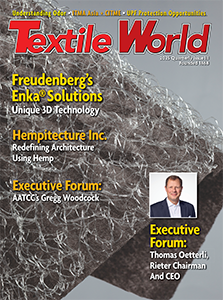BOXMEER, The Netherlands — March 12, 2018 — SPGPrints’ digital printing solutions using Archer® technology and advanced rotary screens for apparel applications will be presented on its stand in Hall 6, Stand 606B, at ITM 2018, Tűyap Fair Convention and Congress Center, Istanbul, Turkey, from April 14-17.
Highlights of the digital offering at the stand will be the 1850 millimeter (mm)-wide version of the JAVELIN® printer, a program of inks for a wide range of fabrics, and information on other digital printers using Archer technology.
“Since its debut at ITM 2016, the Javelin printer has been installed at textile printing operations around the world, complementing existing digital machines and screen production,” said Hakan Uzman, managing director SPGPrints Turkey. “For the past year, Tekboy Tekstil, here in Istanbul, has been running its Javelin printer to supplement production capacity and meet increased demands for shorter runs, rapid turnarounds, and on-demand sample printing.”
The six-color Javelin is a production scanning printer that uses SPGPrints’ unique Archer technology and Fujifilm Dimatix Samba print heads to fire variable drops of ink (2-10 pL) up to 4 mm to the substrate.
With an output of up to 367 linear meters per hour, the Javelin is suited for medium output levels, and situations where more frequent changes between different fabrics and ink chemistries are required.
For higher volumes, information will be available on the stand about the SPGPrints PIKE® printer that offers high-speed, single-pass production using the same proven Archer technology. Capable of speeds up to 40 linear meters per hour, Pike is enabling users to offer lead times of less than one week to global fast-fashion brands, for orders exceeding 100,000 linear meters.
With both printers, SPGPrints’ “Archer Print Head Program” is available that provides a 2.5 year guarantee on print heads in combination with the use of accredited inks.
In addition to production flexibility, the Javelin and Pike printers deliver high-quality print with fine lines, solid blotches, precise geometrics, and micro patterns, making them ideal for today’s design trends and demands for fast-fashion.
SPGPrints manufactures its own inks for use with Javelin and Pike printers at its recently expanded ink plant, at its headquarters in Boxmeeer. SPGPrints’ NEBULA® range of digital inks is designed for use with printers using Kyocera print heads. Acid, reactive, disperse and sublimation inks are available, and assure smooth running, wide colour gamuts, and outstanding quality with low maintenance.
Screens for exceptional print quality
SPGPrints continues to lead the way in innovation for screen technologies because it recognises the complementary nature of digital and screen production in meeting the demands of today’s markets quickly and cost-effectively.
On its stand at ITM 2018, visitors will find a selection of screens and printed textiles that demonstrate the characteristics of the NovaScreen® line-up. NovaScreen screens offer relatively high open areas thanks to mesh counts with minimum spacing between holes, maximising paste transfer, and are available in a range of meshes from 135 and 245 holes per linear inch. This results in higher printing speeds and paste yields. The robust nickel construction of NovaScreen offers stability at high speed, long life and easy handling.
The NovaScreen 245 mesh offers exceptional definition and resolution. With hole-sizes of 40 microns, it features an exceptionally high mesh count. This gives it two important quality advantages: first, it prints perfect halftones and tonal gradations, with transitions not previously possible with rotary screen printing. Fine rasters that generate homogenous shade impressions on the printed substrate make this possible. Fine linework and smaller dots can also be reproduced, enabling greater creativity in geometric patterns and halftones for fashion and interior décor applications.
Also on the stand will be SPGPrints’ RandomScreen®, a 125 mesh with a 79-micron hole-size screen, that supresses moiré effects in halftones. The holes are arranged stochastically, out of line with each other, thereby eliminating the risk of undesired patterns becoming visible in printed results. RandomScreen also can save paste, especially when pigment printing.
Optimize images with direct laser engraving and laser imaging
To achieve the best results from SPGPrints’ NovaScreen line, direct laser engraving and laser imaging solutions can cut screen preparation times, accelerate throughput and increase productivity. Information about these laser engraving systems will be available at the stand.
The SPGPrints bestLEN offers state-of-the-art direct laser engraving for effortless, repeatable quality in screen imaging. Direct laser engraving is a single-step dry process: simply engrave the desired design and print. This eliminates costly consumables such as film, ink or chemicals, and time-consuming processes like exposing and washing.
SPGPrints’ smartLEX 7430 laser exposing system uses unique multi-beam diode technology that combines long lifetime, high productivity and resolutions of up to 2540dpi. smartLEX 7430 exposes screens between 300 mm and 3500 mm length. Exposing cycles can be as short as 12 minutes, and intuitive, easy-to-use, Smart-GUI software requires relatively little experience to master.
“There is no doubt that the textile printing market is currently a very exciting place to be. With powerful digital printers working alongside advanced screen technologies using precision laser engraving and imaging systems, new applications like soft signage, and new market dynamics are driving this vital industry,” Uzman concluded. “With products for the complete workflow, SPGPrints is in a unique position to help its customers find the right solutions for success.”
Posted March 12, 2018
Source: SPGPrints




